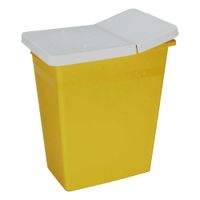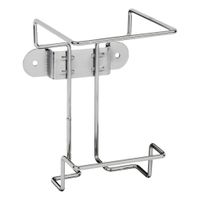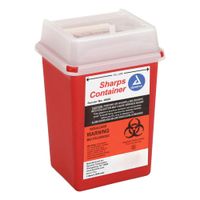Call +(254) 703 030 000 / 751 483 999 / 721 704 777
- Home
- Safety
- Safety Storage
- Safety Disposal Containers
.....Read More
Frequently Asked Questions
What are the types of hazardous waste disposal containers?
Hazardous waste disposal containers are designed to safely store and transport hazardous materials to prevent environmental contamination and ensure human safety. The types of hazardous waste disposal containers include:
1. **Drums and Barrels**: Typically made of steel or high-density polyethylene (HDPE), these are used for storing liquid and solid hazardous wastes. They come in various sizes, commonly 55-gallon, and are suitable for chemicals, oils, and other industrial wastes.
2. **Intermediate Bulk Containers (IBCs)**: These are large, reusable containers made from plastic, metal, or a combination of materials. They are used for storing and transporting bulk quantities of hazardous liquids and solids.
3. **Pails and Buckets**: Smaller containers, often made of plastic or metal, used for less hazardous materials or smaller quantities. They are ideal for laboratory waste or small-scale industrial applications.
4. **Lab Packs**: These are used for disposing of small quantities of laboratory chemicals. They consist of a larger outer container filled with absorbent material and smaller inner containers holding the waste.
5. **Cylinders**: Used for storing and transporting compressed gases. They are made of metal and designed to withstand high pressure.
6. **Overpack Drums**: These are larger containers used to contain and transport damaged or leaking smaller containers. They provide an additional layer of protection.
7. **Sharps Containers**: Specifically designed for the disposal of needles, syringes, and other sharp medical instruments. They are puncture-resistant and often made of rigid plastic.
8. **Bags and Liners**: Used for asbestos, contaminated soil, or other solid wastes. They are made from heavy-duty plastic and are often used as liners within other containers.
9. **Tanks**: Large, stationary containers used for storing large volumes of liquid hazardous waste. They are typically made of steel or reinforced plastic.
Each type of container is selected based on the nature of the waste, regulatory requirements, and the need for safe handling and transportation.
How do you properly dispose of biohazardous waste?
To properly dispose of biohazardous waste, follow these steps:
1. **Identification**: Identify waste types, such as sharps, pathological waste, microbiological waste, and blood-soaked materials.
2. **Segregation**: Separate biohazardous waste from regular waste at the point of generation. Use color-coded bags and containers: red for biohazardous waste, yellow for pathological waste, and puncture-resistant containers for sharps.
3. **Containment**: Use leak-proof, labeled containers with biohazard symbols. Ensure containers are sealed and not overfilled to prevent spills.
4. **Storage**: Store waste in a designated, secure area with restricted access. Maintain appropriate temperature controls for pathological waste to prevent decomposition.
5. **Transportation**: Use licensed biohazard waste transporters. Ensure waste is transported in compliance with local, state, and federal regulations, using appropriate vehicles and documentation.
6. **Treatment**: Treat waste to neutralize pathogens. Common methods include autoclaving, incineration, chemical disinfection, and microwave treatment. Choose a method based on waste type and regulatory requirements.
7. **Disposal**: Dispose of treated waste in accordance with local regulations. Incinerated waste can be sent to landfills, while autoclaved waste may be disposed of as regular waste if rendered non-hazardous.
8. **Documentation**: Maintain records of waste generation, transportation, treatment, and disposal. Ensure compliance with regulatory requirements and facilitate audits.
9. **Training**: Provide regular training for personnel handling biohazardous waste to ensure safety and compliance with protocols.
10. **Compliance**: Adhere to regulations set by agencies like OSHA, EPA, and local health departments to ensure safe and legal disposal practices.
What materials are considered hazardous waste?
Hazardous waste refers to materials that pose substantial or potential threats to public health or the environment. These materials are typically classified based on their characteristics, which include:
1. **Ignitability**: Wastes that can easily catch fire, such as solvents, gasoline, and alcohols. They have a flash point of less than 60°C (140°F).
2. **Corrosivity**: Substances that can corrode metals or have a very high or low pH, such as strong acids (e.g., hydrochloric acid) and bases (e.g., sodium hydroxide).
3. **Reactivity**: Materials that are unstable under normal conditions, can cause explosions, or release toxic gases when mixed with water. Examples include lithium-sulfur batteries and certain cyanides.
4. **Toxicity**: Wastes that are harmful or fatal when ingested or absorbed, such as lead, mercury, and certain pesticides. These can leach into groundwater and pose health risks.
Common examples of hazardous waste include:
- **Industrial Waste**: By-products from manufacturing processes, such as chemical residues, heavy metals, and solvents.
- **Household Waste**: Items like batteries, paints, cleaning agents, and electronic waste (e-waste) containing hazardous components.
- **Medical Waste**: Infectious materials, pharmaceuticals, and sharp objects from healthcare facilities.
- **Agricultural Waste**: Pesticides and herbicides that can contaminate soil and water.
Proper management and disposal of hazardous waste are crucial to prevent environmental contamination and health risks. This involves treatment, recycling, or safe disposal in designated facilities. Regulations, such as the Resource Conservation and Recovery Act (RCRA) in the U.S., govern the handling and disposal of hazardous waste to ensure safety and compliance.
How do HPLC waste cans differ from regular waste containers?
HPLC waste cans are specifically designed to handle the unique requirements of high-performance liquid chromatography (HPLC) waste, which often includes hazardous solvents and chemicals. These cans differ from regular waste containers in several key ways:
1. **Material Compatibility**: HPLC waste cans are typically made from materials that are resistant to the corrosive and reactive nature of the solvents used in HPLC processes, such as stainless steel or high-density polyethylene (HDPE). Regular waste containers may not offer the same level of chemical resistance.
2. **Safety Features**: HPLC waste cans often include features like flame arresters, pressure relief valves, and secure sealing mechanisms to prevent the release of volatile organic compounds (VOCs) and reduce the risk of fire or explosion. Regular waste containers generally lack these safety features.
3. **Ventilation**: Many HPLC waste cans are equipped with venting systems to safely release pressure build-up from volatile solvents, preventing dangerous pressure accumulation. Regular waste containers are not typically designed with such ventilation systems.
4. **Labeling and Compliance**: HPLC waste cans are usually clearly labeled for hazardous waste and comply with regulatory standards for the disposal of chemical waste, such as those set by OSHA or EPA. Regular waste containers may not meet these regulatory requirements.
5. **Capacity and Design**: HPLC waste cans are often designed with specific capacities and shapes to fit under HPLC equipment and accommodate tubing connections for direct waste disposal. Regular waste containers may not be suitable for such configurations.
6. **Spill Prevention**: These cans often have features to prevent spills and leaks, such as secure lids and secondary containment options, which are crucial for handling hazardous waste safely. Regular waste containers may not provide the same level of spill prevention.
Overall, HPLC waste cans are specialized to ensure the safe and compliant disposal of hazardous chemical waste generated in laboratory settings.
What are the regulations for disposing of hazardous waste?
Regulations for disposing of hazardous waste are primarily governed by the Resource Conservation and Recovery Act (RCRA) in the United States. The Environmental Protection Agency (EPA) enforces these regulations to ensure safe management and disposal of hazardous waste to protect human health and the environment.
1. **Identification**: Waste generators must first determine if their waste is hazardous. This involves checking if the waste is listed by the EPA or exhibits characteristics such as ignitability, corrosivity, reactivity, or toxicity.
2. **Generator Categories**: Based on the amount of hazardous waste produced, generators are classified into three categories: Very Small Quantity Generators (VSQGs), Small Quantity Generators (SQGs), and Large Quantity Generators (LQGs). Each category has specific requirements for waste management.
3. **Storage**: Hazardous waste must be stored in appropriate containers that are clearly labeled and in good condition. Storage areas must comply with regulations to prevent leaks and spills.
4. **Transportation**: Only certified transporters can move hazardous waste. The waste must be accompanied by a Uniform Hazardous Waste Manifest, a tracking form that details the waste's journey from cradle to grave.
5. **Treatment and Disposal**: Hazardous waste must be treated to neutralize its hazardous properties before disposal. Treatment and disposal facilities must have permits and comply with strict operational standards.
6. **Recordkeeping and Reporting**: Generators must maintain records of waste generation, transportation, and disposal. They must also submit periodic reports to the EPA or state agencies.
7. **State Regulations**: States may have additional or more stringent regulations than federal requirements. Generators must comply with both federal and state regulations.
8. **Penalties**: Non-compliance with hazardous waste regulations can result in significant fines and legal action.
These regulations ensure that hazardous waste is managed responsibly to minimize risks to health and the environment.
How do you safely store flammable waste materials?
To safely store flammable waste materials, follow these guidelines:
1. **Use Appropriate Containers**: Store flammable waste in containers made of metal or other non-combustible materials. Ensure they are designed for flammable substances, with tight-fitting, spark-resistant lids to prevent vapor escape.
2. **Labeling**: Clearly label containers with the type of waste and hazard symbols. This ensures proper handling and reduces the risk of accidental ignition.
3. **Ventilation**: Store containers in a well-ventilated area to prevent the accumulation of flammable vapors. This reduces the risk of ignition from static electricity or other sources.
4. **Temperature Control**: Keep storage areas cool and away from direct sunlight or heat sources. High temperatures can increase vapor pressure and the risk of explosion.
5. **Segregation**: Store flammable waste separately from incompatible materials, such as oxidizers, acids, or bases, to prevent chemical reactions that could lead to fires or explosions.
6. **Grounding and Bonding**: Ground and bond containers during transfer to prevent static electricity buildup, which can ignite flammable vapors.
7. **Spill Containment**: Use secondary containment systems, like spill pallets or trays, to catch leaks or spills and prevent them from spreading.
8. **Access Control**: Limit access to storage areas to trained personnel only. This minimizes the risk of mishandling or accidental ignition.
9. **Fire Safety Equipment**: Equip storage areas with appropriate fire extinguishers and ensure they are easily accessible. Regularly inspect and maintain fire suppression systems.
10. **Regular Inspections**: Conduct routine inspections of storage areas and containers for signs of leaks, corrosion, or damage. Address any issues immediately to maintain safety.
11. **Compliance**: Follow local regulations and guidelines for the storage and disposal of flammable waste to ensure legal compliance and safety.
What accessories are available for HPLC waste cans?
Accessories for HPLC waste cans are designed to enhance safety, efficiency, and convenience in handling and disposing of hazardous waste generated during High-Performance Liquid Chromatography (HPLC) processes. Key accessories include:
1. **Safety Funnels**: These are designed to prevent spills and exposure to hazardous chemicals. They often come with lids that can be closed to minimize vapor release.
2. **Vapor Filters**: These are used to capture and neutralize harmful vapors emitted from the waste solvents, protecting laboratory personnel from exposure to toxic fumes.
3. **Level Sensors**: These sensors alert users when the waste can is nearing capacity, preventing overflows and ensuring timely disposal.
4. **Tubing and Connectors**: These accessories facilitate the direct transfer of waste from the HPLC system to the waste can, minimizing the risk of spills and exposure.
5. **Caps and Adapters**: These are used to securely seal the waste can, preventing leaks and vapor release. They often come with multiple ports to accommodate various tubing sizes.
6. **Secondary Containment Trays**: These trays are placed under waste cans to catch any accidental spills or leaks, providing an additional layer of safety.
7. **Labels and Tags**: Proper labeling is crucial for identifying the contents of waste cans, ensuring safe handling and compliance with regulatory requirements.
8. **Grounding Wires**: These are used to prevent static electricity buildup, which can be a fire hazard when dealing with flammable solvents.
9. **Waste Can Liners**: These liners make it easier to dispose of waste and keep the interior of the waste can clean.
10. **Spill Kits**: These kits contain absorbent materials and other tools necessary for quickly addressing spills, ensuring a safe laboratory environment.
These accessories are essential for maintaining a safe and efficient laboratory environment when dealing with HPLC waste.



